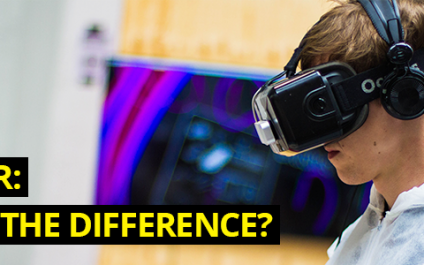
Two rising tech terms that we frequently hear are augmented reality (AR) and virtual reality (VR). It can be difficult to distinguish the difference between the two, so for this month’s newsletter we have broken them down.
Understanding the basics
For background, both AR and VR fall under the concept of mixed reality (MR). According to Reality Technologies’ article, “Mixed reality…attempts to combine the best of both virtual reality and augmented reality. When both real and virtual worlds are merged together, new environments and visualizations become possible where physical and digital objects can coexist and interact in real time.”
Virtual Reality: Immersed in a new environment
The popularity, advancement, and availability of Virtual Reality (VR) has skyrocketed during the 21st century. VR is defined as "the use of computer technology to create a simulated environment.” When using VR, you are completely immersed into this computer environment. Reality Technologies explains how “Total immersion means that the sensory experience feels so real, that we forget it is a virtual-artificial environment and begin to interact with it as we would naturally in the real world.” You must use special headwear (like the Oculus Rift) that covers your eyes and allows you to look in any direction of this virtual world. VR worlds can be artificial (completely computer generated, like simulating a zombie apocalypse on a distant planet) or a real place that has been photographed or filmed (like wandering through the stalls of Seattle’s Pike Place Market.) VR is most commonly used in video games, but can also be applied to different fields—like simulating training for airplane mechanics or incoming surgeons.
Augmented Reality: Enhancing your own environment
On the other hand, augmented reality (AR) has proven to be a more practical tool for enhancing our everyday lives. It lies in the middle of the mixed reality spectrum, blending the real world and the virtual world. The word “augmented” means “having been made greater in size or value.” In the context of AR, we can think of this as “enhancing” reality. Reality Technologies clarifies that “Unlike virtual reality, which requires you to inhabit an entirely virtual environment, augmented reality uses your existing natural environment and simply overlays virtual information on top of it.” AR is most commonly used in apps, with a famous example being Pokémon Go, a game that was released and immediately popularized in 2016. Stephanie Lee says, “The game works by using your phone’s GPS for your real-world location and augmented reality to bring up those cool-looking Pokémon on your screen, overlaid on top of what you see in front of you.” There are endless applications for augmented reality, from GPS to construction sites, auto repair, and more.
To conclude, we believe that humans are just scratching the surface of mixed reality: whether that’s virtual reality, where you are completely immersed into a virtual world, or augmented reality, where you use a device to enhance the real world you interact with. Major tech companies like Google, Apple, Microsoft, and Facebook are furiously researching and developing breakthroughs to make this technology more affordable and applicable for the everyday consumer. Mixed reality can be applied to essentially any industry, and all of us at SWAT are excited to keep up with new developments!


